
The Royal Navy (RN) is the United Kingdom's naval warfare force and a component of His Majesty's Naval Service. Although warships were used by English and Scottish kings from the early medieval period, the first major maritime engagements were fought in the Hundred Years' War against France. The modern Royal Navy traces its origins to the early 16th century; the oldest of the UK's armed services, it is consequently known as the Senior Service.

The Type 23 frigate or Duke class is a class of frigates built for the United Kingdom's Royal Navy. The ships are named after British Dukes, thus leading to the class being commonly known as the Duke class. The first Type 23, HMS Norfolk, was commissioned in 1989, and the sixteenth, HMS St Albans was commissioned in June 2002. They form the core of the Royal Navy's destroyer and frigate fleet and serve alongside the Type 45 destroyers. They were designed for anti-submarine warfare, but have been used for a range of uses. Eleven Type 23 frigates remain in service with the Royal Navy, with three vessels having been sold to the Chilean Navy, and one being retired in 2021, and a second one being retired in 2023.

HMS Montrose was the eighth of the sixteen-ship Type 23 or Duke class of frigates, of the Royal Navy, named after the Duke of Montrose. She was laid down in November 1989 by Yarrow Shipbuilders on the Clyde, and was launched on 31 July 1992 by Edith Rifkind, wife of Malcolm Rifkind, Secretary of State for Defence. She was commissioned into service in June 1994.

The Type 45 destroyer, also known as the D or Daring class, is a class of six guided-missile destroyers built for the United Kingdom's Royal Navy in the early 21st century. The class is primarily designed for anti-aircraft and anti-missile warfare and is built around the PAAMS air-defence system using the SAMPSON Active electronically scanned array (AESA) and the S1850M long-range radars. The first three destroyers were assembled by BAE Systems Surface Fleet Solutions from partially prefabricated "blocks" built at different shipyards; the remaining three were built by BAE Systems Maritime – Naval Ships. The first ship in the Daring class, HMS Daring, was launched on 1 February 2006 and commissioned on 23 July 2009.
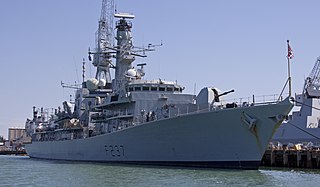
HMS Westminster is a Type 23 frigate of the Royal Navy, and the second ship to bear the name. She was launched on 4 February 1992 and named for the Dukedom of Westminster.

HMS Northumberland is a Type 23 frigate of the Royal Navy. She is named after the Duke of Northumberland. She is the eighth RN ship to bear the name since the first 70-gun ship of the line in 1679, and the ninth in the class of Type 23 frigates. She is based at Devonport and is part of the Devonport Flotilla.
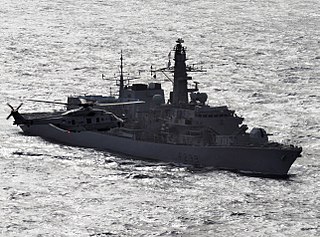
HMS Richmond is a Type 23 frigate of the Royal Navy. She was launched on 6 April 1993 by Lady Hill-Norton, wife of the late Admiral of the Fleet The Lord Hill-Norton, and was the last warship to be built by Swan Hunter Shipbuilders. She sailed from the builders on the River Tyne in November 1994. She is named for the Dukedom of Richmond.

The Type 14 Blackwood class were a ship class of minimal "second-rate" anti-submarine warfare frigates. Built for the Royal Navy during the 1950s at a time of increasing threat from the Soviet Union's submarine fleet, they served until the late 1970s. Twelve ships of this class served with the Royal Navy and a further three were built for the Indian Navy.

Future planning of the Royal Navy's capabilities is set through periodic Defence Reviews carried out by the British Government. The Royal Navy's role in the 2020s, and beyond, is outlined in the 2021 defence white paper, which was published on 22 March 2021. The white paper is one component of the Integrated Review of Security, Defence, Development and Foreign Policy, titled as Global Britain in a Competitive Age which was published on 16 March 2021.
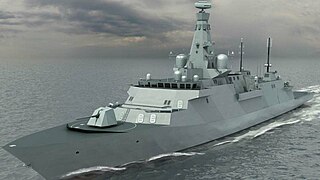
The Type 26 frigate or City-class frigate is a class of frigate being built for the United Kingdom's Royal Navy, with variants also being built for the Australian and Canadian navies. The programme, known as the Global Combat Ship, was launched by the UK Ministry of Defence to partially replace the navy's thirteen Type 23 frigates, and for export. Its primary role is to conduct advanced anti-submarine warfare missions while supporting air defence and general purpose operations. The type is the first naval platform shared between Australia, Canada and the United Kingdom since the Tribal-class destroyer.

The River class is a class of offshore patrol vessels built primarily for the Royal Navy of the United Kingdom. A total of nine were built for the Royal Navy (RN), four Batch 1 and five Batch 2. One Batch 1 (HMS Clyde), which was the Falklands guard ship, was decommissioned and transferred at the end of its lease to the Royal Bahrain Naval Force.
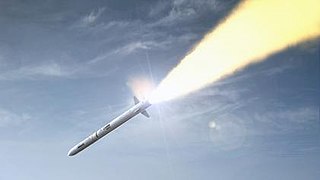
The CAMM is a family of surface-to-air missiles developed by MBDA UK for the United Kingdom. CAMM shares some common features and components with the ASRAAM air-to-air missile, but with updated electronics and an active radar homing seeker.
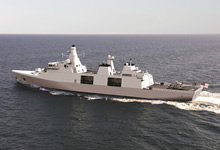
The Type 31 frigate or Inspiration class, and formerly known as the Type 31e frigate or General Purpose Frigate (GPF), is a planned class of frigate intended to enter service with the United Kingdom's Royal Navy in the 2020s alongside the submarine-hunting Type 26 frigate. Designed by Babcock International, it is also marketed under the name Arrowhead 140 and is based on Odense Maritime Technology’s (OMT) Iver Huitfeldt-class frigate hull.
A Littoral Response Group (LRG) is a Royal Navy task group consisting of at least two amphibious warfare ships, a company of Royal Marines and supporting elements primarily tasked with amphibious warfare from the littoral areas. They were first deployed in 2020 and have been described by the Royal Navy as being more flexible and agile compared to previous amphibious task groups with an emphasis on forward-basing, precision strike capabilities, high mobility, modern command and control technology, networked autonomous systems and deception capabilities. Multiple LRGs can combine to form a more substantial Littoral Strike Group (LSG) and they can also join a UK Carrier Strike Group to form an Expeditionary Strike Force.
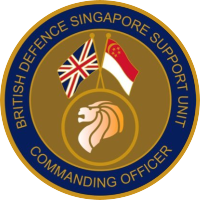
The British Defence Singapore Support Unit (BDSSU) is a British naval facility located in Sembawang, Singapore. A remnant of a larger naval base, known as HMNB Singapore, the facility provides fuel and other supplies to Royal Navy ships in the region, as well as those of other countries. It is the only permanent Royal Navy presence to remain at the former naval base, which is maintained by Naval Party 1022 under the auspices of the Five Power Defence Arrangements (FPDA).
HMS Active is a planned Type 31 frigate and the thirteenth vessel of the Royal Navy to carry the name. In May 2021, the names of the five planned Type 31 ships were announced by the First Sea Lord. The names were selected to represent key themes that represent the future plans of the Royal Navy and Royal Marines - forward deployment of ships overseas; operating in the North Atlantic; carrier operations; technology and innovation; and the Future Commando Force.
HMS Formidable is a Type 31 frigate of the Royal Navy and the sixth vessel named after the word formidable. In May 2021, the names of the five planned Type 31 ships were announced by the First Sea Lord. The names were selected to represent key themes that represent the future plans of the Royal Navy and Royal Marines - forward deployment of ships overseas; operating in the North Atlantic; carrier operations; technology and innovation; and the Future Commando Force.
HMS Venturer is the lead ship of the Type 31 frigate-class currently under construction for the Royal Navy and the seventh vessel named HMS Venturer.
HMS Campbeltown is a Type 31 frigate of the Royal Navy and the third vessel named after Campbeltown, a town in Argyll and Bute in Scotland. In May 2021, the names of the five planned Type 31 ships were announced by the First Sea Lord. The names were selected to represent key themes that represent the future plans of the Royal Navy and Royal Marines, with Campbeltown after first ship to bear the name, which was pivotal in the St Nazaire raid, a major commando attack on the occupied port of St Nazaire and the destruction of its dry dock in 1942. The plan for the Type 31 project envisages all five units of the class being in service by February 2030.













